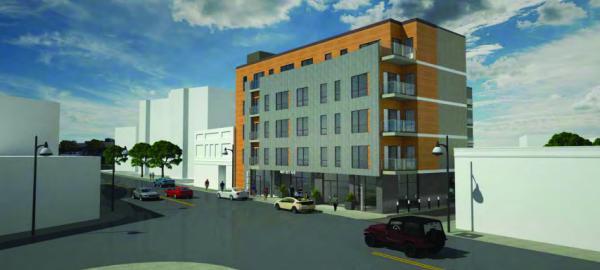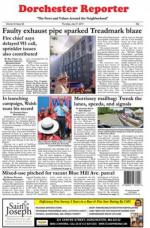March 2, 2017

Connelly Construction hopes to build a new five-story building on its property at 1857-1859 Dorchester Avenue. It would include 20 rental units and two retail spaces on the ground level.
About 30 neighbors and business owners gathered at St. Mark’s Church hall on Monday night to discuss a proposed five-story, mixed use development slated for a stretch of Dorchester Avenue near Peabody Square. The building proposal is presently under review by the Boston Planning and Development Agency (BPDA), which hosted the meeting. Several people took the opportunity to air their concerns about the development’s potential effect on the community, particularly for neighboring buildings and parking.
Connelly Construction, which owns the property at 1857-1859 Dorchester Avenue, hopes to erect a 26,896 square foot building with 20 rental units and two retail spaces on the ground level. The rentals will be primarily two-bedrooms, with three units meeting the BPDA’s Inclusionary Development Policy for affordable housing.
Kevin Cloutier, an attorney representing Connelly Construction, explained that the company will own, develop, and manage the property, filling one of the retail spaces with their own offices.
“Activating an underused piece of property and transitioning it into a residential development will make that small chunk of Dorchester Avenue look better to pedestrians, drivers, and businesses,” said Cloutier.
Cheryl Tougias from Spalding Tougias Architects spoke about the building design. There will be about 4,000 square feet of green space replacing what is currently asphalt, as well as parking for cars and bicycles.
“It’s a balancing act between getting the open space, the parking, the materials, and the number of units right,” she said.
Some aesthetic issues came up right away, with some neighbors concerned about the five-story structure dwarfing other buildings around it or the surrounding neighborhood becoming too “cookie-cutter.”
Mike DeMarco, who lives on Dorchester Avenue next-door to the proposed building said, “I’m not exactly thrilled that it’s going to be five stories.”
DeMarco was concerned about the character of the neighborhood, as well as his own home.
“Our roof is right there, and if they have open windows or balconies, litter and trash could fall onto it,” he said, adding that this could affect solar panels that were being considered for his building.
DeMarco also wanted to know more about potential commercial usess on the ground floor of the development.
“If we’re going to undertake a project at this magnitude that will be a cornerstone in our community, we should give serious consideration to the purposes of the retail units,” he said.
John Bennett, who also lives next-door to the proposed building, said, “One of my concerns is that you’re going to be attaching to the wall that is right by my built-in headboard.”
Bennett’s space “is literally a bunker with no cell signal,” he said, yet he still feels movement from the Ashmont T station. Bennett asked that they use a strong material such as concrete to offset any shaking.
“The vibration is extremely intense. It feels like a really bad Las Vegas motel bed,” he said.
Bennett, along with many others who spoke at the meeting, said he is concerned about parking on Dorchester Avenue and how the proposed building would affect the busy street.
“You can’t pull out of these driveways without putting your life at risk every time,” he said.
While some thought that the amount of parking was necessary — about 1.5 spaces per unit with more for retail — others disagreed.
Mike Folan, vice-president of the St. Mark’s Area Civic Association said, “Parking is very, very important, and a serious situation in this area.”
A discussion about the amount of parking, the volume of traffic, and the proximity of the Ashmont T became a major debate in regards to the development. Folan described how the area is packed with cars in the morning, but empties out during the afternoon.
“Let nobody here tell me that these people took their vehicles with them on the train,” he said.
Chris Stanley, who lives nearby and uses Zipcar, suggested that more data could be found on parking to determine how much is needed for new developments.
“I agree that it’s an emotional subject,” he said during the debate.
The Small Project Review submission to the BPDA had a traffic analysis, where the development was classed as “low impact.” The analysis estimates that there are 13,000 vehicles on Dorchester Avenue each day.
“We’re talking about Dorchester Avenue, this is the main commercial corridor in our neighborhood,” said Stanley.
The Article 80 comment period—a BPDA process required for larger projects— ends on March 10.
Villages:
Topics:



